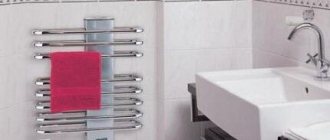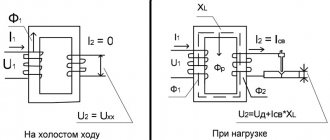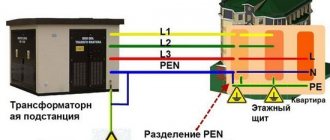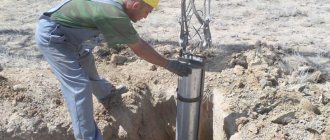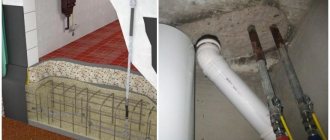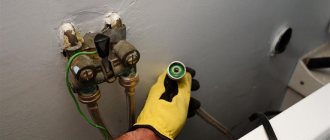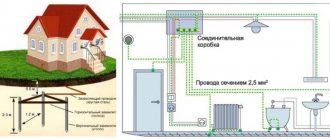For what? How?
The title of the article will surprise many. Does it need to be grounded? For what? There is no direct answer to the question. But we will try to clearly describe the problem and give ways to solve it. Any questions - call
The fact is that so-called “stray currents” lead to electrochemical corrosion of metal parts of the water supply system. Electrocorrosion affects all water supply systems to one degree or another, but at different rates.
And if the heated towel rail is leaking , this is a signal to check the entire system, because... he suffers first.
Modern stainless steel heated towel rails with welded joints are at risk. Like “ladder”, “snake” and the like. If the heated towel rail is leaking, then, as a rule, that’s where it is.
By the way, for this reason, the most reliable heated towel rails are the classic S-shaped ones , because they do not have welded elements. And air jams do not form in them. There is nothing new - everything ingenious is simple, and the beauty of non-standard forms, alas, requires sacrifice.
Do I need to ground a heated towel rail?
First you need to know that grounding (constructing grounding loops with your own hands) is not required if:
- 1. You are using an electric heated towel rail (such heated towel rails are usually equipped with special plugs that contain a grounding wire, all this is connected to an outlet, and the outlets themselves must already be connected to the ground loop).
- 2. You live in a private house or apartment, and you have a separate heating system.
The heated towel rail must be grounded in the following cases:
- 1. If your dryer is connected to the heating system with a metal-plastic pipe. Inside the metal-plastic pipe there is aluminum, which conducts electric current: at the joints where the fittings are located, the electrical circuit is broken. Accordingly, such a heated towel rail must be connected to a ground loop or to a hot water supply riser.
- 2. If your hot water supply system is made of metal-plastic pipes.
How to ground a heated towel rail
All electric heated towel rails, as mentioned above, are connected to a grounded socket, and such dryers have a grounding wire with a separate contact on the plug. Since heated towel rails are usually installed in the bathroom, you should inspect the outlet to which it will be connected. Such an outlet must be in a special protective casing that prevents moisture from getting inside the outlet itself.
There are 2 main ways to ground a heated towel rail:
- 1. Using a potential equalization system, which must be installed manually, then ground this system to the general grounding of the electrical panel. This should be done if in a house or apartment, instead of metal communications, communications made of polymers (metal-plastic pipes) are used.
- 2. Grounding directly the pipe of the heated towel rail body with a regular wire to the steel riser.
To implement grounding of the heated towel rail in the second way, you first need to acquire a clamp, having first removed all the insulating materials from it. This clamp must have a terminal for connecting the wire. Then the clamp is attached to the pipe of the heated towel rail body.
An ordinary copper wire is taken, which should have a cross-section of 4 mm2. This wire on one side is connected to the clamp terminal, the other end must be connected either to the ground of the electrical panel or to a steel riser. In addition, do not forget to connect other devices located in your bathroom to the ground loop.
| Such methods do not require much time to implement, but in return you get long and uninterrupted operation of the heated towel rail, and in the future the question “how to ground a heated towel rail” will not cause difficulties. |
Friends, also watch the video why you need to ground a heated towel rail.
You have noticed that the stainless steel heated towel rail in the bathroom is beginning to become covered with rust spots the size of 2-3 match heads. And if you wipe this stain, then behind it there is a small, barely noticeable dot, which rusts and spreads over the surface. This is metal corrosion. And rock has nothing to do with it. Metal structures located in water and earth are subject to two types of corrosion: galvanic and so-called “corrosion from stray currents”.
Why are heated towel rails made of stainless steel?
The creators of modern heated towel rails give preference to stainless steel when choosing materials. For this they have at least three reasons, substantiated by experience and experiments:
Chemical
A hot water supply system usually contains water with a relatively large amount of air, or more precisely, oxygen. To withstand such an oxidizing attack, certain types of metals and alloys are needed. For example, copper, brass or stainless steel. By the beginning of the 21st century, stainless steel became the most popular of these examples. The most obvious reasons for this choice of producers and users: consumer properties and economic benefits.
Mechanical
Theoretically, the service life of a conventional water heated towel rail made of fairly high-quality stainless steel is about fifty years. Resistance to mechanical damage and the absence of external coatings such as chrome or enamel are a serious advantage for long service life. Of course, there are technologies such as “steel-enamel” , but they are not yet widely used for heated towel rails.
Aesthetic
However, relying on the reliability of a steel structure does not mean that stainless steel heated towel rails can only be “mirror-colored.” They will be happy to cover the model chosen by the buyer with a colored or tint layer of ion plasma sputtering . In addition, it is possible to cover design radiators with a velvet flock layer of polymers.
Weak point of stainless steel
Such a phenomenon as electrocorrosion can damage a stainless steel water heated towel rail in a very short period of time: from a week to a year and a half. The so-called stray currents contribute to the active occurrence of oxidation reactions between iron from the steel alloy and oxygen dissolved in water. That is, the steel, of course, remains “stainless”, but without electricity. The reasons for the appearance of electric currents in the heating and water supply systems can be different: grounding of a washing machine or electromagnetic water filter, proximity to a railway or tram tracks, and even the chemical composition of water. In the case of electrocorrosion from the railway (up to 3 km), grounding the heated towel rail will not help save it, but on the contrary will contribute to the accelerated destruction of the stainless steel. It is hardly possible to determine the presence of stray electrical currents in advance at home. Previously, only one solution was found for such situations: an electric heated towel rail .
Relatively recently, Sunerge specialists proposed an even more elegant way out of the problem: coating steel pipes from the inside with a polymer insulating material.
We wish you a clear understanding of what and why heated towel rails are made.
What are stray currents and the reasons for their occurrence in scientific language
The reasons for the occurrence of stray electric currents in the heating and water supply systems are very different - from the absence or improper grounding of electrical appliances directly connected to the riser of the heated towel rail, such as a washing machine, electromagnetic filter, circulation pump, to the proximity of the railway and tram tracks.
Stray currents arise not only from external, but also from internal sources, namely due to a short circuit. Theoretically, with proper construction, there should be no short circuits in the system, but in practice it turns out differently. In some places, the welding joint is replaced with conventional bends or a piece of pipe is replaced with metal plastic, so stray currents arise, and all this leads to electrical and electrochemical corrosion.
When the entire riser consists of metal pipes, and in apartments they are replaced with plastic ones, stray currents arise due to different types of pipes. All this happens because all metal pipes are grounded during construction. In new houses, for example, grounding occurs through a potential equation system, and in old houses in basements - along a ground loop. And when installing plastic, this metal connection between the pipes and the heated towel rail is leveled, and stray currents appear. Consequently, the already existing potential is broken: it turns out that there will be one on the riser, and another on the heated towel rail.
Another common cause of electrocorrosion is the potential difference between two different materials in close proximity to each other, especially black and stainless steel.
Also, damage to this plumbing is caused by stray currents that arise in the event of poor wiring insulation, a network break, or if someone (maybe even on another floor of an apartment building) connects the neutral wire from the electrical network to the heating system for personal gain. Damage is also possible if grounding is done to the heating system. The place where the charge penetrates the body of the heated towel rail undergoes a chemical reaction: it inevitably leads to damage to the product. These problems are solved by grounding the heated towel rail or potential equalization.
Before you buy a water heated towel rail, read this article; it will be useful to know this before your bathroom renovation is completed.
Causes
Many who have installed a heated towel rail at home have encountered the problem of electrocorrosion of the device. One of the main causes of corrosion is stray currents. To cope with this problem, it is enough to ensure a strong metal connection between the connection riser pipes and the heated towel rail pipes. That is, it is necessary to ground the pipes.
Another cause of corrosion can be water. But not in terms of its chemical composition, which will negatively affect the condition of the pipes, but the fact is that water, when circulating through the pipes, rubs against them, thereby generating a certain amount of current, which can also lead to corrosion.
Another factor causing stray currents in the heated towel rail can be an unscrupulous neighbor who, in order to save his day, put a magnet on the water meter and connected to the heating system, now the cubic meters of water are counted in the opposite direction, the currents accumulate in your heated towel rail.
Why ground a water heated towel rail?
First you need to know that grounding (constructing grounding loops with your own hands) is not required if:
- 1. You are using an electric heated towel rail (such heated towel rails are usually equipped with special plugs that contain a grounding wire, all this is connected to an outlet, and the outlets themselves must already be connected to the ground loop).
- 2. You live in a private house or apartment, and you have a separate heating system.
The heated towel rail must be grounded in the following cases:
- 1. If your dryer is connected to the heating system with a metal-plastic pipe. Inside the metal-plastic pipe there is aluminum, which conducts electric current: at the joints where the fittings are located, the electrical circuit is broken. Accordingly, such a heated towel rail must be connected to a ground loop or to a hot water supply riser.
- 2. If your hot water supply system is made of metal-plastic pipes.
All electric heated towel rails, as mentioned above, are connected to a grounded socket, and such dryers have a grounding wire with a separate contact on the plug. Since heated towel rails are usually installed in the bathroom, you should inspect the outlet to which it will be connected. Such an outlet must be in a special protective casing that prevents moisture from getting inside the outlet itself.
There are 2 main ways to ground a heated towel rail:
- 1. Using a potential equalization system, which must be installed manually, then ground this system to the general grounding of the electrical panel. This should be done if in a house or apartment, instead of metal communications, communications made of polymers (metal-plastic pipes) are used.
- 2. Grounding directly the pipe of the heated towel rail body with a regular wire to the steel riser.
An ordinary copper wire is taken, which should have a cross-section of 4 mm2. This wire on one side is connected to the clamp terminal, the other end must be connected either to the ground of the electrical panel or to a steel riser. In addition, do not forget to connect other devices located in your bathroom to the ground loop.
| Such methods do not require much time to implement, but in return you get long and uninterrupted operation of the heated towel rail, and in the future the question “how to ground a heated towel rail” will not cause difficulties. |
After plastic pipes began to replace ordinary metal pipes, they began to ignore their grounding, mistakenly believing that a metal pipe and a metal-plastic pipe have the same conductivity. This is wrong. There is no contact between the metal-plastic pipe and the aluminum: they are not connected.
Practice shows that 90 percent of heated towel rails begin to leak precisely when metal hot water supply systems are replaced with their plastic counterparts (for example, polypropylene). Old metal pipes are replaced with modern plastic ones in order to reduce eddy currents. However, corrosion continues to manifest itself.
The first symptoms of electrical corrosion are the appearance of rust spots on the heated towel rail, and rust appears even on devices made of stainless steel. In general, all metal electrical products in contact with water are subject to both electrochemical and galvanic corrosion. Electrocorrosion occurs in the presence of stray currents.
When two different metals come into contact, one of which is more chemically active than the other, both metals undergo a chemical reaction. Pure water is a very poor conductor of electric current (dielectric), but due to the high concentration of various impurities, water turns into a kind of electrolyte.
Do not forget that temperature has a great influence on electrical conductivity: the higher the temperature of the water, the better it conducts electric current. This phenomenon is known as “galvanic corrosion”, which is what systematically renders the heated towel rail unusable.
Innovative technology for protecting heated towel rails
Electrocorrosion is considered the biggest problem with stray currents. The heated towel rail is already exposed to a fairly high degree of risk. Due to the fact that hot water passes through the pipes, salts accumulate on the inner walls, interfering with the passage of the coolant. Due to the effect of electricity on water, the effect of galvanic corrosion occurs, when the loss and deposition of salts accelerates, and the corrosion processes of the metal also intensify, in other words, rust begins to affect the pipe many times more strongly.
Taken together, all these factors lead to rapid failure of the heated towel rail. Usually the manufacturer talks about 5 years of service, but a stainless steel heated towel rail can in fact withstand 20-30 years of use.
If there are stray currents, electrocorrosion will destroy the metal in 2-3 years and there will be no fault with the manufacturer. Incorrect installation is to blame.
However, manufacturers of heated towel rails have tried to anticipate this fact and make more expensive products with corrosion protection. This product is advertised as protection aimed specifically at electrocorrosion, but in fact the innovation also protects against salt deposition.
To preserve the heated towel rail, the manufacturer coats the inner surface of the pipe with a special polymer. Thus, electricity from the pipe cannot affect the water. At the same time, the inner surface becomes smooth, which prevents the deposition of salts, which means that such a coating protects the pipes from overgrowing.
But don’t think that such innovation is a panacea. We must not forget that stray currents are not only electrocorrosion, but also a danger of electric shock. From the point of view of corrosion activity, the coating will really protect the heated towel rail. But for your own safety, it is better to ground the heated towel rail.
Why haven’t similar difficulties arisen before?
Strange as it may sound, progress has become the reason for the emergence of such a problem as potential difference in engineering systems. Namely, the widespread replacement of metal pipes with plastic ones. As long as the hot water supply, hot water supply and heating pipelines were completely metal, no difficulties arose. And there was no need to separately ground each radiator, faucet or heated towel rail either - all pipes were grounded centrally in the basement of the house, in two places. And all metal appliances in bathrooms and toilets automatically became safe and protected from stray currents.
The transition to plastic changed everything: on the one hand, pipelines began to last longer, and on the other hand, there was a need for additional protection of plumbing equipment. And here it’s not only about the pipes themselves, because in terms of conductivity, metal-plastic is close to traditional metal, but also about the fittings - connecting elements. More precisely, in the materials from which they are made and which cannot provide electrical contact with the aluminum “core” of the metal-plastic pipe.
First signs of corrosion
You can determine that your heated towel rail has become a “victim” of corrosion processes by the appearance of the equipment. The first signs of metal destruction are:
- swelling of the decorative layer (paint) - first this occurs at joints and on sharp edges of the structure;
- the appearance on the affected surface of a noticeable whitish coating, reminiscent of fine powder;
- the formation of small dents and depressions in the damaged areas - it seems that the metal has been eaten by a bug.
Minor damage is usually the result of galvanic corrosion caused by the difference in electrical potential of dissimilar metals, one of which acts as a cathode and the other as an anode. And if you add stray currents to this, the destruction will be much more serious.
Measurement methods
When laying a pipeline, stray currents are calculated by measuring the potential difference between two points on the earth's surface, perpendicular to each other and located at an equal distance of 100 m. Measurements are made every kilometer.
Measuring instruments must have an accuracy class of at least 1.5 and an intrinsic resistance of 1 MOhm. The potential difference between the measuring electrodes should not exceed 10 mV. In terms of time, one measurement should last at least 10 minutes, with the result recorded every 10 s.
Measurements in the area of operation of electric transport should be carried out during peak load. If the potential difference exceeds 0.04V, then this is a sign of the presence of stray currents.
A pair of reference electrodes can be used as measuring instruments: copper-sulfate portable and connecting. In addition, you will need a digital multimeter to take measurements, as well as a flexible insulated wire, the length of which must be at least 100 meters.
Despite its small significance, this phenomenon can cause significant damage to underground (and other) communications. The sources of stray currents can be very different. Therefore, it is necessary to take all preventive measures to eliminate this undesirable effect.
Finally, we recommend watching a useful video that clearly shows how to protect yourself from this phenomenon:
So we looked at the causes of stray currents and protection against them. Now you know what it is and how to get rid of this phenomenon even at home!
You probably don't know:
1. Essence of the method
The essence of the method is to measure the potential difference along the route of the designed structure between two points on the ground every 1000 m in two mutually perpendicular directions with the measuring electrodes separated by 100 m to detect stray currents.
Voltmeters with an internal resistance of at least 20 kOhm per 1 V scale with measurement limits: 0.5-0-0.5 V; 1.0-0-1.0 V; 5.0-0-5.0 V or other close to the specified limits. Copper sulfate reference electrodes.
(Changed edition, Amendment No. 1).
3. Taking measurements
The measuring electrodes are placed parallel to the future route of the structure, and then perpendicular to the axis of the route.
Voltmeter readings are taken every 5-10 s for 10-15 minutes at each point.
If the largest swing of the potential difference (the absolute potential difference between the largest and smallest values) exceeds 0.50 V, this indicates the presence of stray currents.
(Changed edition, Amendment No. 1).
APPENDIX 5 Recommended
Remedies
The only way to prevent the appearance of stray currents is to remove the possibility of leakage from the conductors, which are the same rails, into the ground. For this purpose, they build embankments of crushed stone and install wooden sleepers, which are needed not only to obtain a solid foundation for the rail track, but also increase the resistance between it and the ground.
Additionally, installation of gaskets made of dielectric materials is practiced. But all these methods are more suitable for railway lines; it is difficult to isolate tram tracks in this way, since this leads to an increase in the level of the rails, which is undesirable in urban conditions.
Also read: First aid for electric shock
In the case of distribution points and substations, power lines, the situation can be corrected by using more advanced automatic shutdown systems. But the capabilities of such equipment are limited, and constant power outages, especially in industrial settings, are undesirable.
Therefore, in most cases, they resort to protecting pipelines, armored cables and metal structures located in the area of stray currents.
Active and passive protection
There are two main methods of protection:
- Passive - prevents metal contact through the use of coatings made of dielectric materials.
It is for this purpose that coating with bitumen mastics, winding with dielectric insulating tapes, and a combination of these methods are used. But such pipes are more expensive, and the problem is not completely solved, because if such coatings are deeply damaged, the protection practically does not work. Passive protection - Active - based on the removal of stray currents from protected highways.
Can be done in several ways. It is considered the most effective solution. Active protection
In different conditions, different methods of protection against electrochemical corrosion are used. Let's look at a few basic examples.
Protection of heated towel rails
The main difference is that they are located in the open air, so insulation will not help, and there is nowhere to divert stray currents. Therefore, the only acceptable option is potential equalization.
To solve this problem, simple grounding is used. That is, they restore the conditions that existed before the chain was broken using polymer pipes. This requires grounding of each heated towel rail or heating radiator.
Water pipe protection
In this case, sacrificial protection using an additional anode is more suitable. This method is also used to prevent scale formation in electric water heating tanks.
An anode, most often magnesium, is connected to the metal surface of the pipe, forming a galvanic couple. In this case, stray currents do not exit through the steel, but through such a sacrificial anode, gradually destroying it. The metal pipe remains intact. It should be understood that the protective anode needs to be replaced from time to time.
Gas pipeline protection
To protect these objects, two methods are used:
- Cathodic protection, in which the pipe is given a negative potential through the use of an additional power source.
- Electrical drainage protection involves connecting the gas pipeline to the source of the problem with a conductor. This prevents the formation of a galvanic couple with the soil surrounding the main line.
Please note that significant damage caused to metal structures requires the use of comprehensive measures. These include protection and prevention of hazards.
How to ground plumbing and why it needs to be done
Modern apartments are in most cases overcrowded with a variety of household appliances and metal products. The bathroom is no exception. In small toilet rooms you can see a large selection of electrical appliances and plumbing items that are potentially dangerous to humans. Even an acrylic bathtub is included in this list, although it is made of dielectric material. This product is capable of accumulating a powerful charge of static electricity, which can cause significant damage to a person. In addition, the acrylic container is installed on a metal frame, and it conducts electricity well.
All this suggests that grounding in the bathroom must be created, although there are no special requirements in regulatory documents in this regard. For a private house or country house, creating a grounding loop in the bathroom will not be difficult, but in apartments of multi-storey buildings you will have to bring out the grounding wire to the floor distribution board and connect it to a special bus. We will consider below how to protect various plumbing items from the appearance of dangerous electric voltage on them and how to ground a bathtub in an apartment.
Important! The grounding conductor has green-yellow insulation and is designated on the wiring diagrams by the letters PE. This is necessary in order not to confuse the grounding cable with the power lines of the facility's power supply.
Grounding old bathtubs
In Soviet times, cast iron or steel were mainly used to make bathtubs. These products did not provide special structural elements that are necessary to connect the ground wire. But this problem can be solved quite simply! To complete the work, you will need the following tools and materials: an electric drill, a drill with a pobedit tip, a jumper for connecting the ground wire, a set of fasteners (bolt, washers and nuts), as well as a stranded copper cable and a distributor of all ground taps.
A hole of the required diameter is drilled in the bathtub leg and a grounding jumper is installed on the threaded connection. A grounding conductor is attached to the jumper and brought out to the switchgear. The device itself must be secured in a convenient place, since all grounding wires from metal products located in the bathroom will be connected to it. From the distributor, the common grounding wire must be led to the distribution board on the floor landing and connected to the protective grounding bus. All this work is quite simple and can be done with your own hands.
Grounding modern cast iron and steel bathtubs
Grounding cast iron bathtubs manufactured in the last decade will not cause problems even for an inexperienced consumer. All of them are equipped with special petals with a mounting kit for connecting the grounding conductor. Simply tighten the bare end of the wire between the washers and bring it out to the distributor. If for some reason the jumper is missing, a hole will need to be drilled. It is best to perform this operation on special thickenings of the bathtub body, which are designed to wedge the load-bearing legs of the product. This option will create reliable contact between the ground wire and the bathtub.
There will be no special problems with steel bathtubs either. They usually have a petal and do not need to drill a hole. It is enough to strip the enamel coating around the hole on the petal down to the metal and use a crimp screw to secure the grounding conductor. All other operations must be performed by analogy with cast iron baths. Next, we will consider the question of whether it is necessary to ground an acrylic bathtub and how to do this work correctly.
Attention! It is prohibited to connect the ground to the removable legs of steel and cast iron bathtubs. This is due to the fact that there is no normal electrical contact between the supporting elements and the bathtub itself!
Grounding acrylic bathtubs
Acrylic bathtubs are becoming very popular sanitary products. It is they who are gradually ousting steel and cast iron products from the market. The main advantage of acrylic bathtubs is their light weight, but at the same time this is a definite disadvantage. There are two types of such products: cast and extruded. The second type of acrylic plumbing products is installed on steel frames, and as we know, metal is an excellent conductor of electricity. Therefore, acrylic bathtub frames must be grounded. Grounding an acrylic bathtub is carried out by analogy with steel products.
Important! Water getting between the body of an acrylic bathtub and the supporting metal frame can lead to the formation of a conductive layer, so this structure must be grounded!
Jacuzzi grounding
If we can argue about the need to ground various models of bathtubs, then for Jacuzzis (hydromassage baths) this procedure is mandatory! This plumbing product is a complex household appliance that consumes electricity, and any electrical appliance in the bathroom must have protection against the appearance of mains voltage on its body. Hydromassage baths are connected to the grounding bus through special sockets designed for installation in rooms with high humidity. They have special curtains in their design that protect the contacts from water getting on them.
Sockets for connecting a jacuzzi are installed at a distance of 30 cm from the floor of the bathroom and 50 cm from the edge of the whirlpool bath. The cable for supplying electricity and the grounding conductor must be double insulated and placed in a corrugated pipe. For a Jacuzzi, a separate RCD and circuit breaker must be installed in the switchboard; in addition to grounding, this will ensure reliable protection of a person from electric shock. The PUE rules prohibit grounding hydromassage baths through the water supply system. It is advisable to involve an experienced electrician in the installation of a jacuzzi, as this will allow you to avoid errors when connecting.
Attention! When installing electrical wiring and protective grounding cables, the use of twists and other unreliable connections that can lead to a broken contact and electric shock to a person is not allowed!
Grounding the heated towel rail
How to ground a stainless steel heated towel rail and is it necessary? The answer to this question can be found in physics textbooks and reference books! There are such concepts as galvanic corrosion and stray currents. These two unpleasant phenomena can reduce the life of the heated towel rail to a minimum! Stray currents occur when electrical energy leaks into the heating system from damaged wiring, household appliances, and for some other reasons. Galvanic corrosion occurs when two dissimilar metals interact with water, which is to some extent an electrolyte.
These two factors can damage a stainless steel heated towel rail, so it should be grounded. Heating systems consisting of metal pipes are initially grounded and additional grounding is not required to equalize potentials on the heated towel rail. But if the heating pipes are plastic, then it is better to connect it to a common ground bus on the distribution board. This operation will not cause any difficulties; it is enough to secure the grounding conductor to the heated towel rail using a metal clamp and remove its zero bus.
Remedies
The only way to prevent the appearance of stray currents is to remove the possibility of leakage from the conductors, which are the same rails, into the ground. For this purpose, they build embankments of crushed stone and install wooden sleepers, which are needed not only to obtain a solid foundation for the rail track, but also increase the resistance between it and the ground.
Additionally, installation of gaskets made of dielectric materials is practiced. But all these methods are more suitable for railway lines; it is difficult to isolate tram tracks in this way, since this leads to an increase in the level of the rails, which is undesirable in urban conditions.
In the case of distribution points and substations, power lines, the situation can be corrected by using more advanced automatic shutdown systems. But the capabilities of such equipment are limited, and constant power outages, especially in industrial settings, are undesirable.
Therefore, in most cases, they resort to protecting pipelines, armored cables and metal structures located in the area of stray currents.
Active and passive protection
There are two main methods of protection:
- Passive - prevents metal contact through the use of coatings made of dielectric materials. It is for this purpose that coating with bitumen mastics, winding with dielectric insulating tapes, and a combination of these methods are used. But such pipes are more expensive, and the problem is not completely solved, because if such coatings are deeply damaged, the protection practically does not work. Passive protection
- Active - based on the removal of stray currents from protected highways. Can be done in several ways. It is considered the most effective solution. Active protection
In different conditions, different methods of protection against electrochemical corrosion are used. Let's look at a few basic examples.
Protection of heated towel rails
The main difference is that they are located in the open air, so insulation will not help, and there is nowhere to divert stray currents. Therefore, the only acceptable option is potential equalization.
To solve this problem, simple grounding is used. That is, they restore the conditions that existed before the chain was broken using polymer pipes. This requires grounding of each heated towel rail or heating radiator.
Water pipe protection
In this case, sacrificial protection using an additional anode is more suitable. This method is also used to prevent scale formation in electric water heating tanks.
An anode, most often magnesium, is connected to the metal surface of the pipe, forming a galvanic couple. In this case, stray currents do not exit through the steel, but through such a sacrificial anode, gradually destroying it. The metal pipe remains intact. It should be understood that the protective anode needs to be replaced from time to time.
Gas pipeline protection
To protect these objects, two methods are used:
- Cathodic protection, in which the pipe is given a negative potential through the use of an additional power source.
- Electrical drainage protection involves connecting the gas pipeline to the source of the problem with a conductor. This prevents the formation of a galvanic couple with the soil surrounding the main line.
Please note that significant damage caused to metal structures requires the use of comprehensive measures. These include protection and prevention of hazards.
Designation of the concept
Stray currents are charged electrical particles with a specific trajectory of movement that appear in the ground, which is a conductor. The term wandering appeared due to the fact that it is impossible to predict the localization of particles and the beginning of the process. The impact of stray electrical particles is very bad on iron products present above and below the ground.
The same processes appear due to the growing number of electrified objects that are the basis of modern countries. And since the soil is a conductor for electricity, there is a mutual action between the elements.
Wandering particles akin to electric ones appear, the mutual action of which requires a comparison of the potential difference at 2 arbitrary points; exclusively for the wandering version, the conductor is the ground. As a result, the iron material located near the process collapses faster due to corrosion.
What are stray currents?
Stray currents are currents that arise in the ground, which is used as a conductive medium. But this is too general a definition. In the case of heated towel rails, stray currents appear as a result of electricity leakage from the wiring as a result of a wire breakdown. The lost current tends to places with low potential, that is, to any metal structures.
Stray currents are dangerous because they cause metal corrosion, which leads to leaks and wear of the heated towel rail. Another dangerous factor is that a device with stray currents is unsafe for humans. Because there is a high risk of getting an electric shock.
To protect yourself from these two factors, you need to do the following:
- Grounding, that is, to ensure a strong connection between the water supply or heating pipes with the heated towel rail. Then the stray currents will disappear and the corrosion process will stop.
- Create a system that will balance the potentials of all pipes.
Stray currents are a common phenomenon and, moreover, dangerous for humans. Therefore, as soon as you notice this feature in your heated towel rail, you need to fix it: by calling a specialist or yourself
A little about the nature of stray currents and their danger
The reason for the appearance of stray currents acting on your heated towel rail is the difference in potential of grounded structures. And in order to equalize the potentials, it is necessary to create a system in which all metal elements will be in contact with the neutral conductor in the existing input distribution device.
Such a system will ensure maximum safety for the user (if you put your hand on a pipe and grounded equipment, you will not receive a fatal discharge)
And this is very important, because the greater the potential difference, the more serious the danger threatens a person. For example:
- If this value is 4 or 6B, you may receive a 5 mA shock. It will be sensitive but not fatal.
- If its strength is 50 mA, cardiac fibrillation may develop.
- And when a human body is exposed to a current of 100 mA, death occurs.
But there are cases where even a small potential difference of 4B became the cause of death.
Explanation in simple human language
The problem with corrosion of faucets and heated towel rails is that you have plastic pipes going to them, but the riser in the house is made of metal pipes.
Metal pipes are all grounded, in new houses through a potential equalization system, in old houses - in the basement to the ground loop. When using plastic pipes, you break the metal connection between the riser pipes and the metal mixer or heated towel rail. Therefore, you break the potential, on the riser you have one - ground, on the heated towel rail - another. It's called potential difference. What appears between different potentials? Current - provided that a conductor appears between them, and such a conductor is the water flowing through the pipes. When water moves through pipes, micro-friction of various media occurs - water and metal, and what happens during friction? Remember the ebonite stick? That's right - tension, i.e. potential, the one in the riser is equal to the potential of the earth (grounded), and the one in the heated towel rail hangs on it by itself, and through the water between different potentials, stray currents arise, and as a result, corrosion. Water definitely has excellent electrical conductivity. In our experience, Aquanerzh heated towel rails resist stray currents best; for this occasion, we are giving a 5% discount on any water model. When placing an order, simply enter the promo code Aquanerzh5
and get a 5% discount.
ALL YOU NEED TO DO is to ensure a reliable metal connection between the riser pipes and the metal terminal devices (mixer, heated towel rail). Simply put, ground your heated towel rail to the metal pipes of the riser, the potential will level out and the current will have nowhere to flow.
Water supply protection
Passive and active methods are used to protect the water supply. Active consists of installing a device that generates a counter electrical signal. The passive method is to use an insulator. In addition, prevention and comprehensive pipeline protection are used as a method of protecting water pipes from stray electric current. Specialists coat the pipes with a polymer composition. As a result, metal corrosion does not occur.
You may be interested in How to check phase and zero
Water supply protection
Passive option
The passive option is the main measure to rid any installation of stray electric current. It is called cathodic protection. Thanks to it, corrosion in long pipelines is eliminated. To perform cathodic protection, a high negative potential is applied to the pipeline. It guarantees the maintenance of a negative pipe potential, regardless of the parameter values caused by stray electric currents in pipeline systems. As a rule, a potential of 6 kilowatts is supplied.
Note! It is believed that in this case, regardless of the medium and electrolyte, there is no positive charge. This is how the pipeline is protected
This method is effective, but has one significant drawback: the elements that are in the medium are deposited on its inner surface. These are elements in the form of paraffins, which significantly reduce the diameter of the pipe and increase the energy required to pump the contents of the pipes. To restore the original internal pipe diameter and remove wax deposits, mechanical cleaning with a brush is usually used.
Passive option
Active protection
The only effective way to protect a pipeline from corrosion caused by stray energy is to reduce the current flowing in different areas to zero. To do this, the master divides the pipe into sections. He applies voltage to them. Thanks to this equalizing method, electricity does not cause corrosion. In this case, the resulting zero from the equation is supported automatically by analog electronics.
Polymer processing - a solution to the problem without grounding
But you can solve the problem in another way by treating the inner surface of a stainless steel water heated towel rail with a special polymer composition. It will create an insulating coating that will “work” effectively, preventing the formation of potential differences and the occurrence of corrosion.
Polymer treatment of water heated towel rails is an additional service that is performed by our company at the buyer’s request. And you can order it online on the ZIGZAG website.
Go to
Methods of protection against stray currents
To prevent the harmful effects of electrochemical potential, protection methods are used, which may differ depending on the characteristics of the metal structures. Let us consider, as an example, methods for protecting water pipes, heated towel rails and gas pipelines, starting in the order given.
Video about various protections against stray currents
Water pipe protection
For metal structures laid in the ground, in particular water pipes, two protection methods are used: passive and active. We will describe each of them in detail.
Passive protection
This technique involves applying a special insulating layer to the surface of metal structures, forming a protective barrier between the ground and the metal shell. Polymers, various types of epoxy resins, bitumen coating, etc. are used as insulating materials.
An example of a protective coating for a pipe for underground installation
Unfortunately, modern technology does not allow creating a protective barrier that provides complete insulation. Any coating has a certain diffusion permeability, so with this method only partial isolation from the ground is possible. In addition, it should be taken into account that during transportation and installation the protective layer may be damaged. As a result, various insulation defects form on it in the form of microcracks, scratches, dents and through damage.
Since the considered method is not sufficiently effective, it is used as a supplement to active protection, which will be discussed below.
Active protection
This term refers to the control of the mechanisms of electrochemical processes that occur at the points of contact of metal structures with the electrolyte formed in the soil. For this purpose, cathodic polarization is used, in which the negative potential displaces the natural one.
Such protection can be realized using the galvanic method or using a direct current source. In the first case, the effect of a galvanic couple is applied, in which the anode is destroyed (sacrificial anode), while protecting the metal structure, which has a slightly lower potential (see 1 in Fig. 5). The described method is effective for soils with low resistance (no more than 50.0 Ohm*m); at lower conductivity levels, this method is not used.
The use of a direct current source in cathodic protection makes it possible not to depend on soil resistance. As a rule, the source is made on the basis of a converter powered from an alternating current electrical circuit. The design of the source allows you to set the level of protective currents in accordance with the current conditions.
Figure 5. Options for implementing cathodic protection
Designations:
- Use of a sacrificial anode.
- Polarization method.
- Metal structure laid in the ground.
- Laying a sacrificial anode in the ground.
- DC source.
- Connecting a poorly soluble anode to a source.
Protection of heated towel rails
Towel rails and other metal terminal devices on water pipes (faucets) were not threatened by corrosion caused by stray currents until plastic pipes began to be widely used in everyday life. Even if metal pipes are installed in your riser, it is not a fact that the neighbor below them is not plastic, and plastic is probably used for pipes to the bathroom and kitchen.
To ensure protection against emergency current leaks and prevent electrocorrosion, it is necessary to equalize the potentials by grounding the heated towel rail, water pipes in the riser, and the heating battery.
Gas pipeline protection
Protecting underground gas pipelines from stray currents that cause corrosion is carried out in the same way as for water pipes. That is, one of two options for active cathodic protection is used, the operating principle of which was discussed above.
Methods for grounding a heated towel rail
There is actually only one way to ground a heated towel rail: using a grounding wire connected to the grounding circuit in the electrical panel. When using plastic in the installation of a heated towel rail, each metal element of the system is grounded. For this:
- The wire must be stripped and then bent into a loop shape.
- The paint is removed from the pipe, and then the stripped part of the wire is placed against the metal part of the pipe.
- The loop is secured with a metal clamp.
- These loops go around all metal parts of the structure.
- The wire is routed to the electrical panel in the entrance and connected to the ground loop.
There is only one way to ground a heated towel rail. In old houses, where a grounding loop is not provided, you will have to make do with metal pipes so as not to break the loop that equalizes the potentials of metal structures.
What do you need to know about stray currents?
Any metal objects located in water or in the ground, regardless of their purpose, are susceptible to corrosion, which can be:
Galvanic
It involves the reaction between different metals. For example, a galvanic couple leading to destruction can be created by steel and brass or steel and aluminum. The reaction begins as soon as a “duet” of different metals is formed and the resulting assembly comes into contact with the electrolyte. In the situation with a heated towel rail, the role of electrolyte is played by ordinary tap water, which reacts with metals due to the content of a significant amount of minerals (the same reaction will occur with sea water rich in salt). And the higher the water temperature, the more active the process of metal destruction occurs. That is why the hulls of ships that sail in the warm southern seas wear out faster than ships in the northern fleet.
Corrosion of stray currents
This process is caused by so-called stray currents that arise in the ground if it functions as a conductive medium. In this case, not only metal objects that are completely in the ground are exposed to destructive effects, but also those that are only in contact with it. But where do these currents come from? It's simple: in most cases, their appearance is the result of leakage from power lines. This group also includes the so-called zero currents present in ungrounded structures.
Grounding as protection against electrocorrosion
To prevent the occurrence of stray currents in the system and protect the heated towel rail from electrochemical corrosion, it is necessary to recreate a stable connection between it and the riser pipe. In other words, you just need to ground the peripheral device by connecting the heated towel rail with a wire to a metal riser, or install a potential equalization system.
It is also important to do this because some unscrupulous residents of apartment buildings, wanting to save money, put bugs on their electricity meters and use pipelines from heating or water supply systems as grounding. And then their neighbors are in real danger, because even just touching a metal battery will give a person a “chance” of getting a fatal electric shock
Selecting components for bath grounding
Typically, in apartments and private houses, a stranded wire with a cross-sectional area of at least 6 square meters is used for grounding and grounding. mm. This cross-sectional area of the grounding conductor is quite sufficient to provide protection against electric shock to a person in residential premises. It is better to choose a copper cable, but in extreme cases you can use aluminum wire or copper-sheathed steel wire. The grounding conductor should be masked. This is necessary not only from an aesthetic point of view, but also to protect the grounding from accidental damage. Usually the cable is hidden in bathroom furnishings, behind screens and plastic panels. To connect the grounding of all items in the bathroom to a common bus, use a special distributor.
